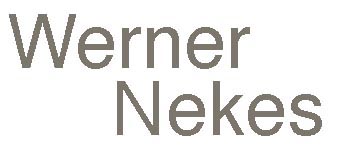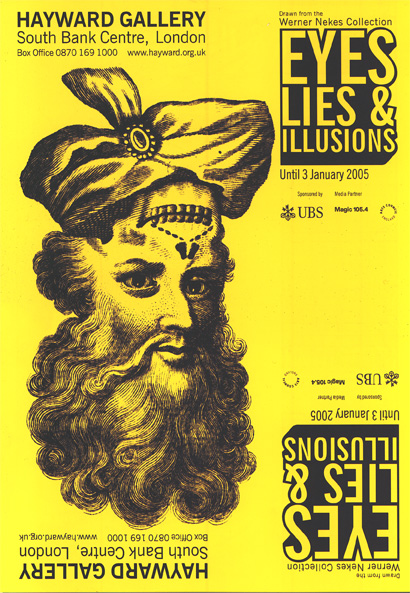"Eyes, Lies & Illusions" Hayward Gallery London
“Lost in the funhouse”
by: Tom Lubbock
in: The Independent Review, 12.10. 2004
A show of optical illusions at the Hayward Gallery blurs the line between science and art. Tom Lubbock is fascinated
Consider the humble thaumatrope, that wild flower of optical gadgetry. Its name means "wonder turn". It was invented in the 1820s, and it is a small flat disc with a different image on either face, and two looped strings attached on either side. Wind the disc on its strings, then pull them out tight, and the disc will spin, and in its whirring blur the two images will blend together and appear as a single image. A squatting demon and a sleeping woman, for example, will become a demon squatting on a sleeping woman.
The thaumatrope demonstrates the persistence of vision. Men different sights alternate or succeed each other very rapidly, our vision doesn't get rid of them quickly enough, and they merge. This limitation is also a gift. It is the basis of cinema and television. A creature with faster eyesight could not enjoy our moving-linage technology. But knowing that doesn’t stop this little scientific toy from being a wonder, too. It causes us to see a picture we know isn’t there. Magic. And it's no surprise that the thaumatrope, like other optical tricks, should be drawn to supernatural imagery, featuring devils, spooks, and skeletons.
There's a bunch of thaumatropes on view in Eyes, Lies and Illusions at Londons Hayward Gallery. And on all sides, the eye is beguiled, dazzled and a little spooked by flitting shadows, jumpy animations, shapeshifting objects, mysterious projections, bizarre gadgetry, grotesques, brain-teasers and jokes. The exhibition is drawn largely from the private collection of Werner Nekes, a German film-maker and optical enthusiast. Assembled over 30 years, it is what a private collection should be - a total miscellany. It is united by a very loose principle: visual surprise.
It has various classes of stuff. There are early moving-image and early projection technologies. There are historic visual aids and classic optical illusions. There are trick pictures and visual toys. To be more specific, you’ll find shadow-plays, peep-shows, magic lanterns, the chrono-photography of Eadweard Muybridge, flip-books, "what the butler saw" machines, zoetropes, telescopes and microscopes, a camera obscura (showing a live projection of Waterloo Bridge) and a camera lucida, wobbly mirrors, pictorial puns and puzzles, stretched and distorted images, hidden images, ambiguous images, negative images, randomly generated images, transparent pictures and two-way pictures, rotating discs, kaleidoscopes, panoramas, optical dazzlers, 3-D illusions, and an Ames room into which you go and walk around and appear to an outside observer to change size dramatically.
Almost everything you've ever seen in a book about optical illusions is here. The historical range is from the Renaissance to the early 20th century And the appeal of the show is extremely wide. Its pleasures are both simple and deep. It's on the borderland of art and fun, science and the supernatural. Highbrows, nerds and children will all be delighted. The exhibition is clearly designed as a half-term and holiday treat. (Note that, in the display of stereoscopic peep-shows, the ones that show "nudes" are set higher up the wall.) And a reviewer coming out of it is going to be like any other visitor -just picking favourites.
So, I particularly enjoyed a 19th-century French toy called "Jeu d'Ovide - Metamorphosis", which is a very complicated version of those children’s books where the different parts of animals get muddled up. Here, long ribbons of imagery, going horizontally and vertically on spools operated by little handles, criss-cross in and out of each other bi a dense interwoven intersection that can generate thousands of variant composite images.
And I particularly enjoyed a 3-D illusion of a human head devised by Lumières, the cinema pioneer. It consists of many sheets of glass, one behind the other, and on to them the photographic image of a bearded man is printed, but the face is divided up into layers of distance, so that on the nearest sheet there's just the tip of his nose. In its strange spectral way, it works very well.
And, of course, I could go on, in no particular order, and to no particular purpose. It's one of the good things about this show that it allows - more or less compels - an unmethodical viewing. Your thoughts can take off in any direction. Lots of themes and histories flow through it. Some of the exhibits are clearly pointing towards the invention of photography and cinema. Some of them are things the surrealists were interested in. Some of them are of unredeemable silliness. You don’t get any real bearings. No topic or field is given priority.
So I am slightly opposed to the way the show also includes a selection of optically minded works of contemporary art. They bring it up to date, but also give it a bias or focus it doesn't otherwise have. Neither contemporary science nor contemporary entertainment are represented, for example. The effect is to suggest that art is really the thing, to which everything else is a contribution or a sidelight.
Still, some of these works are remarkable in themselves. I'd never seen the multi-aspect objects of Markus Raetz before - 3-D duck-rabbits, which from one angle look like one thing, from another something quite different. Here, for example, are a bottle and a glass on a plinth: but walk round them and on the other side they become a glass and a bottle. In another, a head becomes an upside-down head.
Perhaps the most extraordinary experience is the prismatic vision offered by Alfons Schilling's Sehemaschine. I cannot really get my head round what it does or how it does it, but I think it's like this. You put your eyes to a pair of prisms, and the vision of each eye is switched round. I don’t mean the eyesight of left and right are swapped. I mean, the sight of each eye is mirrored and perhaps inverted. And the result - which I would certainly have never guesses – is that the spatial distances of what you're looking at are reversed. Near becomes far. Convex becomes concave. There's a pile of objects against a white wall and the nearest thing to you seems to be the visible area of background wall, neatly framing the objects, whose nearest points, the ridge of a piece of wood say, become their deepest points. The visible world goes inside-out, like a glove. It's one of the strangest things I've ever seen.
And, of course, the impression of magic is never quite absent. Optical illusions always seem somehow deep. We find it difficult to accept we are simply limited creatures whose sensory equipment sometimes goes funny and doesn’t let us make the recognitions and distinctions we expect to make. We're impressed by our ability to see things that aren’t there. We tend to take our limits as a threshold to the beyond our various visual blips and glitches as something visionary a glimpse, a revelation, or at the very least an occasion for rapt attention.
But I'm equally impressed by my cat's attitude to these things, to a looking glass, for example. For as long as she believes her reflection is another, real intruding cat, she is aggressively fascinated. But when she has established that no other cat is present, her fascination stops dead. She looses interest entirely, turns away from the mirror, moves on, and cannot be persuaded to look at it further. In fact, she seems instinctively to repudiate mirror images as a source of irrelevant and confusing information. The illusion, as such, does not excite her curiosity.
Her approach is, in a way, very rational. She distinguishes firmly between the real and the unreal, and sticks to the real in a way that Plato would have found admirable. You could contrast my cat with mirror-pecking budgies, who cannot tell illusion from reality, and with mirror-gazing humans, who can, but are fascinated by illusions. This interest in visual illusion, which some people would call primitive, is a peculiarity of the higher mammals. And in that sense, in a show such as Eyes, Lies, and Illusions - would that it had a permanent museum home -we're looking straight at ourselves.

